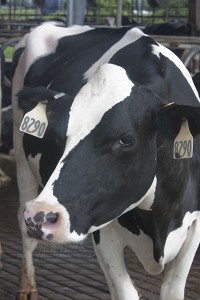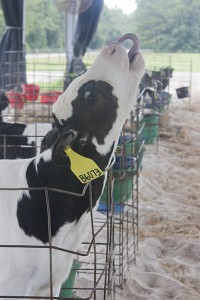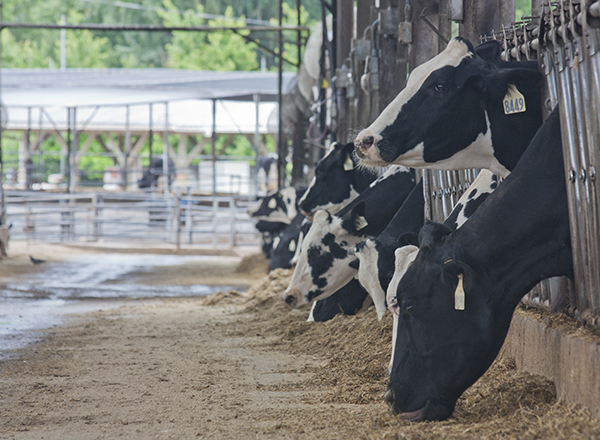Helping dairy cows adjust to a changing climate
Just like dogs, when cows get over-heated, they pant. Long pink pointed tongues hanging down, trying to find some relief.
In the Caribbean and South America, dairy cows can rely on more than just trying to find a shady spot, or changing their breathing to relieve the heat. They’re already built to be cooler.
Almost all cows used for dairy production in the U.S. are breeds that developed in Northern Europe, where sustained warm temperatures are not a major concern.
UFGI dairy faculty are drawing on traits from breeds from warmer climates, such as the Caribbean Senepol, to see how they can breed more heat tolerant dairy cows.
“We’re looking for genes that exist in dairy cows that make them more resistant to heat stress,” said Peter Hansen, distinguished professor in the department of animal sciences.
The UF Dairy Unit houses close to 1,000 cows. Of those 1,000 Holsteins, 30 are different.
If you peer closely, you can see that their coats are shorter than the rest of the herd, the black tint more of a hazy gray. There is no curly lock dangling over their foreheads.
They have an intentionally different genetic make-up from the traditional Holsteins. They are the result of a Holstein being bred with a Senepol, and that offspring being bred with a Holstein.

A “slick” dairy cow.
The purpose? To create a Holstein that possesses the “slick” gene, named for the texture of the coat in cows that possess it.
Hansen thinks this gene may be one key to helping American dairy cows better handle warm weather.
Dairy breeds popular in America were bred with an emphasis on increasing milk production. This has led to cows that give significantly more milk than their ancestors, but are not quite as robust. Their ancestry also means that they stand at a significant disadvantage, as the global climate grows hotter.
A major focus of UFGI dairy researchers is studying means of correcting these deficiencies, and helping cows adapt to the future climate.
“How we can make production more efficient, or find solutions to problems that affect health or reproduction of dairy cows?” asked José Eduardo Santos, foundation research professor in the department of animal sciences, and UFGI faculty member.
During the summer, milk yield decreases 10 to 15 percent. Dairy cows are bred every year in order to keep them producing milk, and to increase the herd. Heat stress often reduces fertility. Heat stress can prevent fertilization of the egg and embryo development.
“They have a really difficult time maintaining their body temperature,” Hansen said. “A dairy cow starts to become hyperthermic at about 75 to 80 degrees Fahrenheit. It doesn’t take much heat stress to make those cows lose their ability to regulate their body temperature.”
UFGI dairy faculty take different approaches to enhancing the physiologies of dairy cows.
Santos is an applied physiologist. He studies the nutrition and reproduction of cows, and uses that data to develop methods for increasing efficiency.
While cows today are more productive than those of the past, they face difficulties their ancestors did not.
With the increased demand for milk, farms have had to become larger, some housing upwards of 5,000 cows. Cows spend less time in the pasture, and more time walking on concrete, which can cause lameness if the concrete is maintained poorly. Many are also being raised in regions that get much hotter for longer periods of time than where they were originally expected to be kept.
“One of the challenges with dairy cows is to get them to become pregnant in a timely fashion,” Santos said.
Like humans, dairy cows are a less prolific species. Gestation lasts nine months.
Also, in order to produce so much milk, their metabolism speeds up, including the metabolism of the hormones responsible for expression of estrus. This can cause cows to have silent heats, making breeding more difficult. Lactating cows experience a shorter estrus period – thus shrinking the window during which they can get pregnant. This becomes even more difficult during the summer.
Santos works on developing breeding programs that fit the physiology of the reproduction of the cow, and can be applied to solve problems of the industry.
“A lot of those programs are now implemented by almost all dairy farms in one way or another in the U.S. as well as abroad,” Santos said.
Francisco Peñagaricano, assistant professor in statistical genetics and genomics, takes a more technological approach.
“The idea is to use different approaches in order to find regions in the cow genome,” Peñagaricano said, “and, if it’s possible, genes and pathways that are responsible for the genetic variation in these traits.”
Peñagaricano focuses on the genetic “merit” of each animal, meaning the sum of the value of its genes. If researchers can identify the genes that influence heat tolerance and general superior health, they can more precisely breed superior cows.

Dairy calves are kept separate from the herd until they are older.
That is where Hansen’s research comes in, “What I’m trying to do genetically is find cows that are better able to regulate their body temperature than other cows, and identify genes controlling that difference.”
That is why the slick gene was introduced into the Holstein.
“Slick” cows not only have less hair, they sweat more. These cows are better able to regulate their body temperature because the short hair allows more heat to escape the body, and enables them to sweat more.
Maintaining milk production during hot seasons is not the only concern. As heat stress can also cause cows to miscarry, UF researchers are also studying how to prevent that. Hansen works identifying genes that protect the early embryo from elevated body temperature in the mother.
“At the cellular level, embryos from some breeds are better able to survive elevated temperatures than other embryos,” Hansen said.
Helping cows acclimate to the demands placed on them will only grow more important going forward.
“We’re continuing to select cows to produce more milk, which should make them more sensitive to heat than they are now,” Hansen said. “There are more and more people on Earth, and they’re going to want to eat. And the world’s going to get hotter.”


